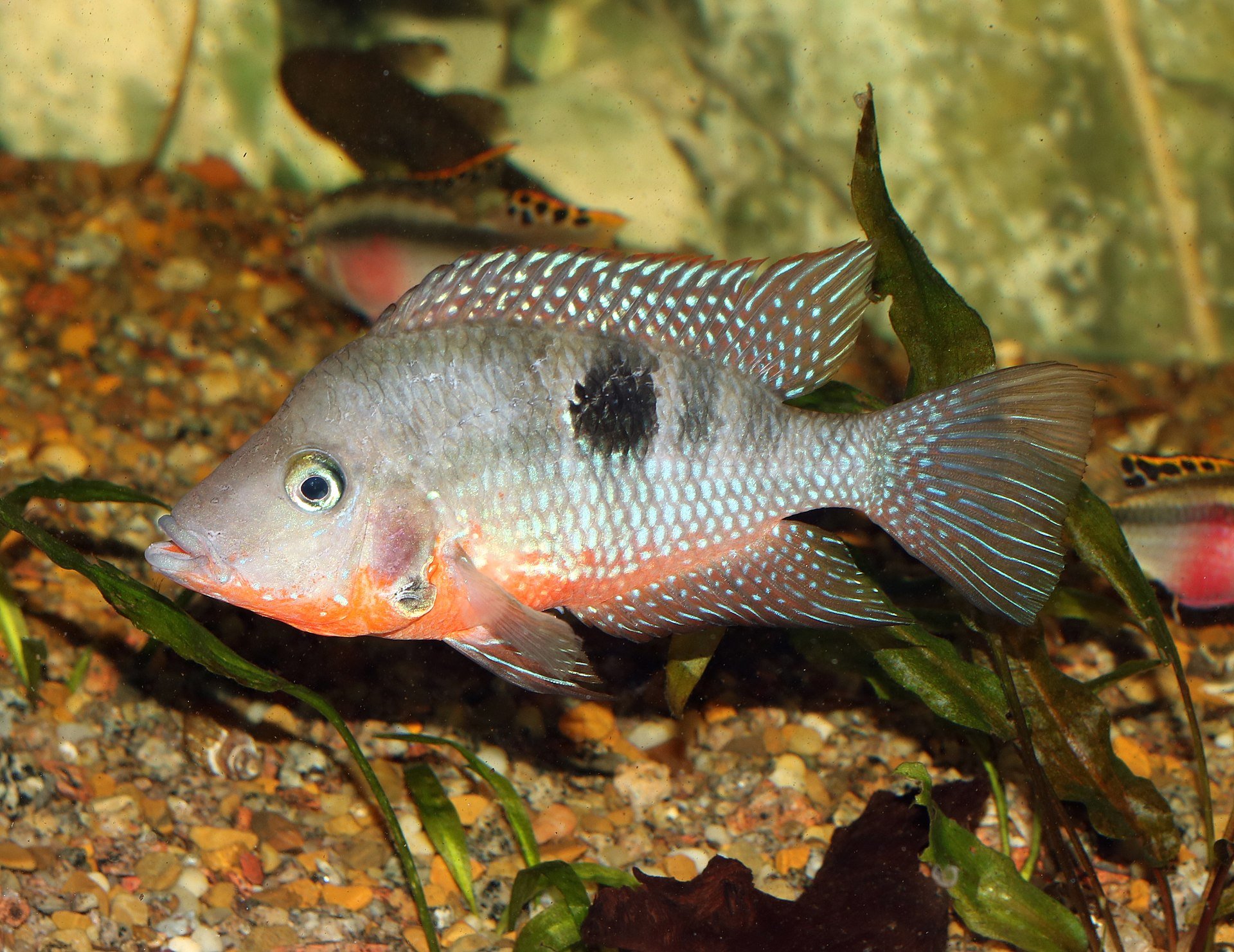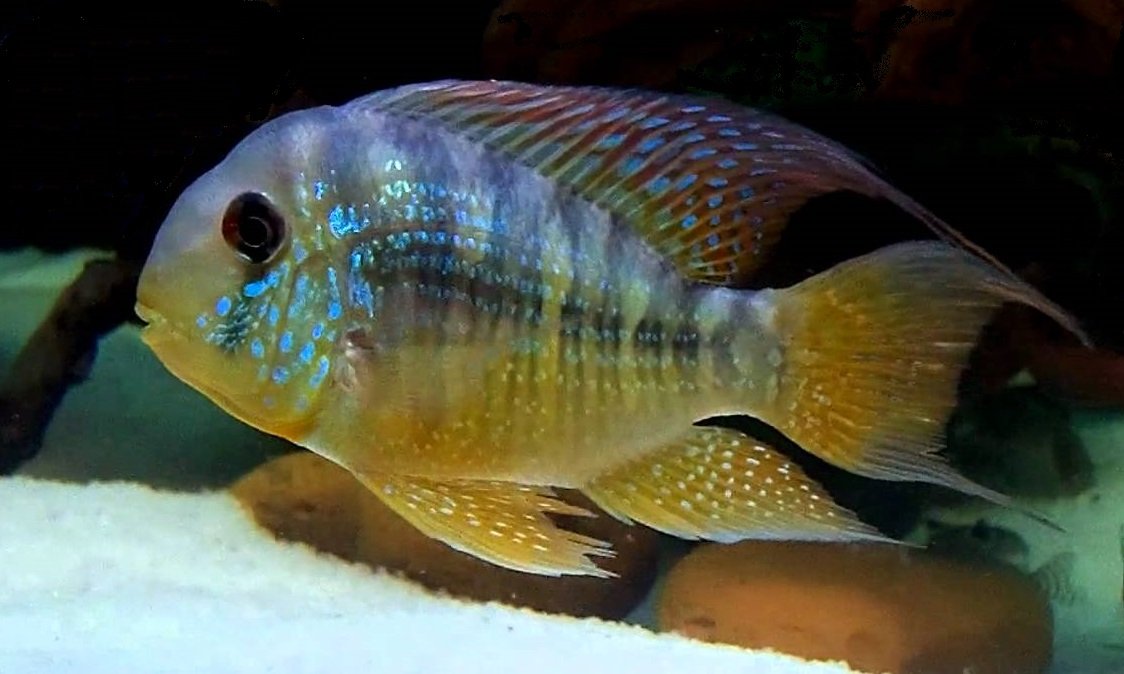 Image 1 of 1
Image 1 of 1


Firemouth Cichlid
The Firemouth Cichlid (Thorichthys meeki) is a popular freshwater fish species among aquarium enthusiasts. Native to Central America, specifically Mexico and Guatemala, Firemouth Cichlids are known for their striking colors and interesting behavior. Here's a care sheet to help you provide the best environment for your Firemouth Cichlids:
1. Tank Setup:
Tank Size: A minimum tank size of 30 gallons is recommended for a pair of Firemouth Cichlids. Larger tanks are preferable, especially if you plan to keep a group.
Substrate: Use fine gravel or sand substrate to mimic their natural habitat.
Decorations: Provide hiding spots and caves using rocks, driftwood, and PVC pipes. Firemouth Cichlids appreciate territories and will establish their own areas.
2. Water Parameters:
Temperature: Maintain a temperature range of 75-82°F (24-28°C).
pH Level: Keep the pH between 6.5 and 8.0.
Water Hardness: They can tolerate a wide range of water hardness, but a neutral to slightly hard water is ideal.
3. Filtration:
Use a good-quality filter to maintain water quality. Firemouth Cichlids can be a bit messy, so efficient filtration is crucial.
4. Lighting:
Provide a natural day-night cycle with a suitable aquarium light. Avoid excessive or direct lighting, as it may cause stress.
5. Feeding:
Firemouth Cichlids are omnivores. Offer a varied diet that includes high-quality cichlid pellets, flakes, live or frozen foods like brine shrimp, bloodworms, and small invertebrates.
Feed them 2-3 times a day, but only what they can consume in a few minutes to prevent overfeeding and water quality issues.
6. Tank Mates:
Firemouth Cichlids can be territorial, especially during breeding. Compatible tank mates include other peaceful cichlids, tetras, and catfish. Avoid keeping them with aggressive or larger species.
7. Behavior:
Firemouth Cichlids are relatively peaceful, but territorial during breeding.
Provide hiding places to reduce aggression and stress.
8. Breeding:
To encourage breeding, create territories with caves and flat surfaces.
The female will lay eggs on a flat surface, and both parents will guard and care for the fry. Provide suitable food for the fry, such as baby brine shrimp or finely crushed flakes.
9. Health:
Monitor water parameters regularly to ensure they remain within the recommended range.
Quarantine new fish before introducing them to the main tank to prevent the spread of diseases.
10. General Tips:
Perform regular water changes to maintain water quality.
Observe your Firemouth Cichlids regularly for any signs of illness or aggression.
Research their natural behavior and habitat to better understand their needs.
By following these guidelines, you can create a suitable and thriving environment for your Firemouth Cichlids. Always be attentive to their behavior and make adjustments as needed to ensure their well-being.
The Firemouth Cichlid (Thorichthys meeki) is a popular freshwater fish species among aquarium enthusiasts. Native to Central America, specifically Mexico and Guatemala, Firemouth Cichlids are known for their striking colors and interesting behavior. Here's a care sheet to help you provide the best environment for your Firemouth Cichlids:
1. Tank Setup:
Tank Size: A minimum tank size of 30 gallons is recommended for a pair of Firemouth Cichlids. Larger tanks are preferable, especially if you plan to keep a group.
Substrate: Use fine gravel or sand substrate to mimic their natural habitat.
Decorations: Provide hiding spots and caves using rocks, driftwood, and PVC pipes. Firemouth Cichlids appreciate territories and will establish their own areas.
2. Water Parameters:
Temperature: Maintain a temperature range of 75-82°F (24-28°C).
pH Level: Keep the pH between 6.5 and 8.0.
Water Hardness: They can tolerate a wide range of water hardness, but a neutral to slightly hard water is ideal.
3. Filtration:
Use a good-quality filter to maintain water quality. Firemouth Cichlids can be a bit messy, so efficient filtration is crucial.
4. Lighting:
Provide a natural day-night cycle with a suitable aquarium light. Avoid excessive or direct lighting, as it may cause stress.
5. Feeding:
Firemouth Cichlids are omnivores. Offer a varied diet that includes high-quality cichlid pellets, flakes, live or frozen foods like brine shrimp, bloodworms, and small invertebrates.
Feed them 2-3 times a day, but only what they can consume in a few minutes to prevent overfeeding and water quality issues.
6. Tank Mates:
Firemouth Cichlids can be territorial, especially during breeding. Compatible tank mates include other peaceful cichlids, tetras, and catfish. Avoid keeping them with aggressive or larger species.
7. Behavior:
Firemouth Cichlids are relatively peaceful, but territorial during breeding.
Provide hiding places to reduce aggression and stress.
8. Breeding:
To encourage breeding, create territories with caves and flat surfaces.
The female will lay eggs on a flat surface, and both parents will guard and care for the fry. Provide suitable food for the fry, such as baby brine shrimp or finely crushed flakes.
9. Health:
Monitor water parameters regularly to ensure they remain within the recommended range.
Quarantine new fish before introducing them to the main tank to prevent the spread of diseases.
10. General Tips:
Perform regular water changes to maintain water quality.
Observe your Firemouth Cichlids regularly for any signs of illness or aggression.
Research their natural behavior and habitat to better understand their needs.
By following these guidelines, you can create a suitable and thriving environment for your Firemouth Cichlids. Always be attentive to their behavior and make adjustments as needed to ensure their well-being.






